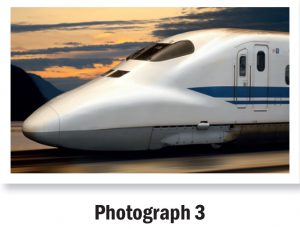Question 3:
Superconductor alloys have many uses now and in the future. Photograph 3 shows one of the uses of superconductor alloy in Maglev trains.

(a) How is a superconductor alloy used in the construction of the Maglev train?
(b) Give two other uses of superconductor alloys in daily life.
(c) In your opinion, can the superconductor alloy be used in the antigravity car manufacturing? Describe the process.
Answer:
(a)
• Superconductor alloys are used in the construction of railway tracks for Maglev train service.
• Magnets are placed at the bottom of the Maglev train.
• Superconductor alloys are cooled to a very low temperature and electric current flows through it to produce antimagnetic property.
• Maglev train will float a little and the bottom part of the train will not be in contact with the railway track.
• This will prevent friction between the railway track and the Maglev train.
• Thus, the Maglev train is able to move at high speed.
(b)
MRI machine/ Electrical cable/ Microchip
(c)
Yes, it can.
• A track needs to be prepared
• Place magnets at the bottom of the car
• When electricity flows on the track, the antimagnetic force will be formed allowing the car to move without touching the track
• The bottom structure of the car is specially created to make sure the car does not derail from the track
No, it cannot
• Cars move without track
• Difficult to place superconductor alloy on the road to allow electricity to flow
• The car can crash because there is no tool to allow the car to be attached to the runway
Superconductor alloys have many uses now and in the future. Photograph 3 shows one of the uses of superconductor alloy in Maglev trains.

(a) How is a superconductor alloy used in the construction of the Maglev train?
(b) Give two other uses of superconductor alloys in daily life.
(c) In your opinion, can the superconductor alloy be used in the antigravity car manufacturing? Describe the process.
Answer:
(a)
• Superconductor alloys are used in the construction of railway tracks for Maglev train service.
• Magnets are placed at the bottom of the Maglev train.
• Superconductor alloys are cooled to a very low temperature and electric current flows through it to produce antimagnetic property.
• Maglev train will float a little and the bottom part of the train will not be in contact with the railway track.
• This will prevent friction between the railway track and the Maglev train.
• Thus, the Maglev train is able to move at high speed.
(b)
MRI machine/ Electrical cable/ Microchip
(c)
Yes, it can.
• A track needs to be prepared
• Place magnets at the bottom of the car
• When electricity flows on the track, the antimagnetic force will be formed allowing the car to move without touching the track
• The bottom structure of the car is specially created to make sure the car does not derail from the track
No, it cannot
• Cars move without track
• Difficult to place superconductor alloy on the road to allow electricity to flow
• The car can crash because there is no tool to allow the car to be attached to the runway